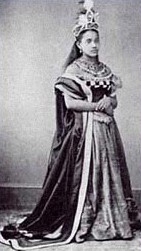In 1878 soprano Marie Selika Williams, known as the “queen of staccato,” became the first black artist to perform at the White House. Marie Selika was born c. 1849 in Natchez, Mississippi. Shortly after her birth, Selika’s family moved to Cincinnati, Ohio where, as a child, Selika began to study music, thanks to the patronage of a wealthy local benefactor. While still in her early 20s, Selika moved to San Francisco, California to study with Signora G. Bianchi under whose tutelage she made her debut as a concert soprano in 1876. Sometime before 1878 Selika met and married a fellow operatic artist, baritone Sampson Williams, who was also known as Signor Velosko, the Hawaiian tenor.
On November 18, 1878, just two years after her concert debut, Marie Selika Williams performed in the Green Room of the White House for an audience that included President Rutherford Hayes and Mrs. Hayes. Her performance included Verdi’s “Ernani, involami,” Thomas Moore’s “The Last Rose of Summer,” Harrison Millard’s “Ave Maria,” and Richard Mulder’s “Staccato Polka.” Her husband, Sampson Williams, also sang, by popular request, the well-known ballad “Far Away” by Bliss.
In the years following her performance at the White House, Williams continued to tour nationally performing for all-black audiences. She interspersed her national performances with two tours of Europe, one from 1882-1885, where she gave a command performance in October of 1883 at St. James Hall for Queen Victoria, and another from 1887-1892. She also toured the West Indies.
Despite Williams’s successful career and her status as the leading black prima donna of her time, she frequently struggled to obtain good professional management, even managing her own concerts on occasion. The prevalent racism of the era prevented black artists from being easily accepted in anything other than Minstrel shows, and blacks would not be welcomed to the American operatic stage until the 1930s.
As Williams approached mid-life in the 1890s, she continued to tour but began to spend more and more time at her home in Cleveland, Ohio where she opened a music studio. After her husband’s death in 1911, Williams retired from the stage, and in 1916, at age 67, she accepted a teaching position at New York’s Martin-Smith School of Music. She died in 1937 in New York at the age of 87.

